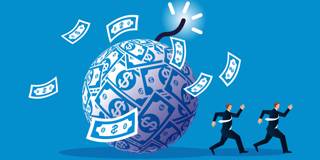Like in World War II, the United States is piling on debt to confront a whole-of-society crisis, raising the question of who will foot the bill in the long term. But, unlike the post-war era, the underlying conditions for robust economic recovery today are less than favorable, placing an even greater onus on wise policymaking.
SAN DIEGO – The United States today not only looks ill, but dead broke. To offset the pandemic-induced “Great Cessation,” the US Federal Reserve and Congress have marshaled staggering sums of stimulus spending out of fear that the economy would otherwise plunge to 1930s soup-kitchen levels. The 2020 federal budget deficit will be around 18% of GDP, and the US debt-to-GDP ratio will soon hurdle over the 100% mark. Such figures have not been seen since Harry Truman sent B-29s to Japan to end World War II.
Assuming that America eventually defeats COVID-19 and does not devolve into a Terminator-like dystopia, how will it avoid the approaching fiscal cliff and national bankruptcy? To answer such questions, we should reflect on the lessons of WWII, which did not bankrupt the US, even though debt soared to 119% of GDP. By the time of the Vietnam War in the 1960s, that ratio had fallen to just above 40%.
WWII was financed with a combination of roughly 40% taxes and 60% debt. Buyers of that debt received measly returns, with the Fed keeping the yield on one-year Treasuries at around 0.375% – compared to the prevailing 2-4% peacetime rates. Ten-year notes, meanwhile, yielded just 2%, which actually sounds high nowadays.

SAN DIEGO – The United States today not only looks ill, but dead broke. To offset the pandemic-induced “Great Cessation,” the US Federal Reserve and Congress have marshaled staggering sums of stimulus spending out of fear that the economy would otherwise plunge to 1930s soup-kitchen levels. The 2020 federal budget deficit will be around 18% of GDP, and the US debt-to-GDP ratio will soon hurdle over the 100% mark. Such figures have not been seen since Harry Truman sent B-29s to Japan to end World War II.
Assuming that America eventually defeats COVID-19 and does not devolve into a Terminator-like dystopia, how will it avoid the approaching fiscal cliff and national bankruptcy? To answer such questions, we should reflect on the lessons of WWII, which did not bankrupt the US, even though debt soared to 119% of GDP. By the time of the Vietnam War in the 1960s, that ratio had fallen to just above 40%.
WWII was financed with a combination of roughly 40% taxes and 60% debt. Buyers of that debt received measly returns, with the Fed keeping the yield on one-year Treasuries at around 0.375% – compared to the prevailing 2-4% peacetime rates. Ten-year notes, meanwhile, yielded just 2%, which actually sounds high nowadays.